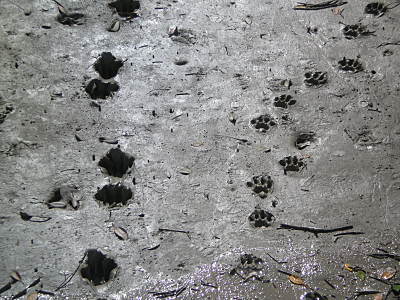Cycle LEJOG
New Zealand S
New Zealand N
Vanuatu - Tanna
Vanuatu - Efate
India - Kolkata &
the Sunderban
India - Andaman
Bhutan
email us
Calcutta is all you have read about India and more. Calcutta, or Kolkata as it is now known since independence, was the capital of the 200 year British involvement in India until it was moved to Deli in 1911. As the capital city, the buildings built by the British are of the same high quality as you would find in central London. However, they are now in a time warp as nothing appears to have been built or maintained since 1947, the year of India’s independence. For example, the following picture is of the Victoria Monument, finished in 1921, set in the main central park.

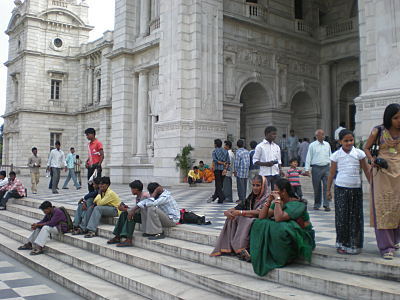
Although this fine marble building is a national museum (entry fee 25p for Indians and £2 for foreigners) it is also home to about 100 pigeons that leave their mess over the walls and exhibits. The following is of the Indian Museum, the oldest and biggest museum in India. The million or so exhibits are housed in a fine building and early 1900s wooden cabinets, again with nothing touched since about 1950.
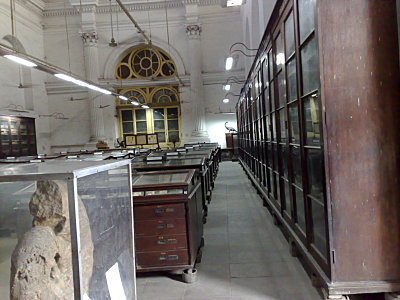
All around the city has reminders of the colonial past, from the shape of the buildings to the name plates – East India Oil Company, National Ship Company, Income Tax office – to the play toys of the English, the polo and race tracks, the national parks, Officers’ club and cricket club.
In the middle of the city there is a haven of Raj nostalgia - the cemetery. Most of the graves are from the early 1800, with the last in the mid 1900, around the time that Britain left India. The size and extravagance of the graves are hard to imagine but as a guide, the pyramid mausoleum in the following picture is about 70 feet high. A quick straw poll of the names, dates of death etc suggests that there were about twice as many British men in Calcutta as women, with about half the men having some form of military title. Most the women died at 20-30, perhaps from child birth. It is interesting to compare the epitaphs of the two sexes, with the men usually described as honourable and upright and the women as dutiful and amenable.
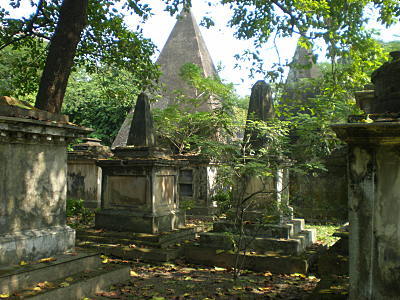
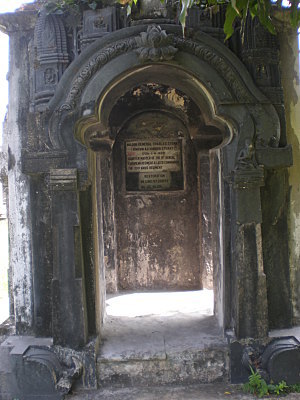
Hinduism is the main religion of this part of India and we arrived during the Hindu festival of Diwali. Most streets have shrines of the Godess Kali. After 3 days of devotion, the Kali effigies were taken from all parts of the city to the river where they float away down the river accompanied by exuberant drumming and dancing. Modern day Hindu women have a much safer existence since 1830. Before it was banned, it was Hindu tradition that a widow should be burnt alive on her husband’s funeral pyre. Why does one get the impression that most religious texts were written by men?
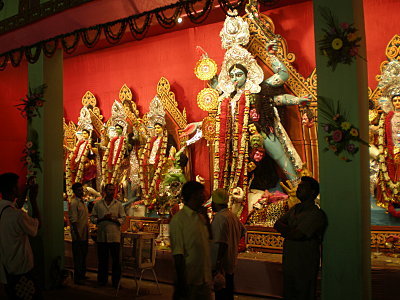
The grand city of Kolkata is now the backdrop for some of the worst living conditions we have encountered. We all know Kolkata as a place of street children and beggars but the experience of this is mind-blowingly awful and is likely to bring a lump to the throat of even the most travelled European. After a time, you can get almost immune to stepping over people sleeping in the middle of the filthy pavements. This filth is a mix of ever present piles of litter, vegetation and human and animal excrement. Roadside drainage ditches are often open and are little more than sewers so the smell is horrendous in places. One almost feels guilty taking pictured of the depravation, so the following is a small sample of the cleaner sights, the first two of the street and the third of the flower market.
Here more than anywhere we have visited we are seen as a cash cow. We accept the desperation of the destitute who send their tiny children to hang onto our arms or grab a water bottle from us – they don’t have much choice. What is more difficult is the growing realisation that every friendly encounter always has a hidden agenda. An approach by someone for a chat about cricket or the current volatile political situation (more about that later) or to help you read the map is actually a sales opening gambit and will eventually end in either a request for money or a forceful invitation to their shop. Their persistence is difficult to imagine, and can last for 5-10 minutes sometimes almost bringing you to the point of violence. If any of these touts or “guides” do manage to sell us their service, after the deal they are markedly less friendly, even sulky. This two-facedness doesn’t do the reputation of the Indian man many favours. Interestingly, outside our hotel, only men have paid work.
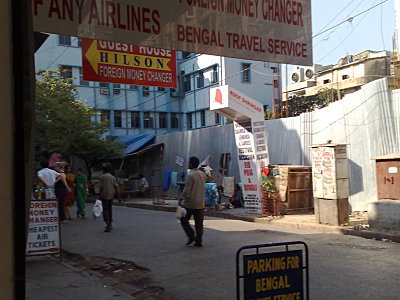
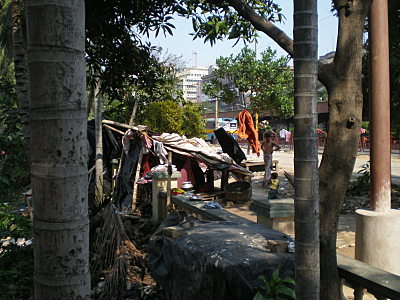
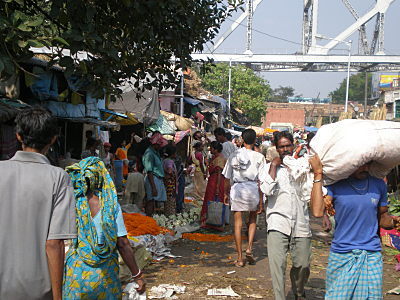
Kolkata was the home for the Mother Teresa refuge movement for the city’s destitute and dying. She started this in 1957, 10 years after independence, having been horrified by the city’s spiralling poverty. Although, to many Europeans she represents all that is good, to some in Kolkata, she and her now international movement, is seen as simply using charity as a tool to convert the city’s largely Hindu population to Catholicism. In a desperately overcrowded city struggling with HIV Aids, she has also been criticised here for her stand against contraception.
Strikes are a common occurrence. Today is the second day of a city strike called by 3 opposition parties to the government. Yesterday almost nothing moved or was open. Streets that were almost impossible to cross a few hours earlier became filled with kids playing cricket. Yet if you ask the shop keepers why they are closed, they will tell you that if they open their shops will be bombed or they will be hit with cricket bats by supporters of the opposition parties.
It is difficult to not draw comparisons between the last 2 countries we visited; India and Vanuatu. Both are very poor. In India the infrastructure is there but decaying, whereas in Vanuatu it has never been there. We mentioned before that in Vanuatu nature provides, but in India, or at least in the city of Kolkata with its 14M population, nature does not provide. Everything must be bought with money and with no social safety net, the poor are very poor. In Vanuatu, with its tribal and village structure, the oldest and most vulnerable would be looked after by the tribe. Here they are just left to die. In Vanuatu everyone appears happy. Here happiness appears to be a rare commodity. However, it is only 60 years since Indian independence. One can only hope, in another 60 years, that life here will be more tolerable.
At least this dog looks content!

Sunderban Tiger Reserve
The most dangerous job in the Sunderban area of West Bengal: honey collector.

There are rich pickings from the wild bees deep in the dense jungle of mangrove swamps but only at a price. On average, 80 villagers a year are eaten by the Royal Bengal tiger, an endangered species of which only about 260 remain in West Bengal.
The only protection of the honey collectors is the offerings they give their gods prior to their annual forage and the belief that a tiger will not attack when being watched, hence the mask. It doesn’t seem to work very well. Interestingly, the same breed of tiger doesn’t attack people in other parts of India. We are bemused as to how tigers are counted given that they are so rarely seen and one looks much like another. The secret lies in taking plaster casts of their footprints from the river mud (they are very good swimmers and will happily take a fisherman from his boat). No two tigers have the same footprint.
This short visit to the tiger reserve is a welcome relief after Kolkata. We have had a glimpse of rural India in a magical and peaceful landscape. Here people are undoubtedly poor but all appear to be housed and well fed and many own bicycles. They also appear far more content that city people, and we are seen less as a cash cow. The whole area is a few feet above sea level, so is likely to disappear in a few years with rising sea levels. It borders Bangladesh.
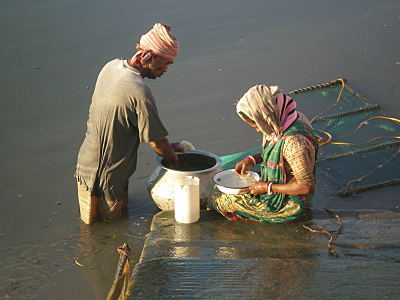
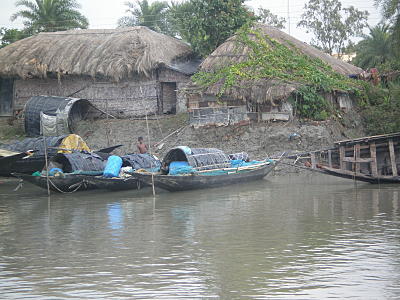
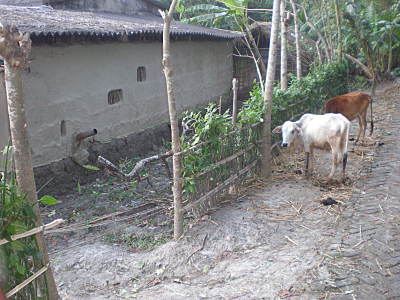
The day before we arrived in the Sunderbans a hurricane was heading for the Sunderbans and Kolkata. Fortunately for the Sunderbans, it changed direction east, but unfortunately for Bangladesh, its devastation killed 1000 people there. Life really is on the edge here. (The foot prints are by a female tiger plus cub)
